The Intel Core i7-7700K (91W) Review: The New Out-of-the-box Performance Champion
by Ian Cutress on January 3, 2017 12:02 PM ESTOffice Performance
The dynamics of CPU Turbo modes, both Intel and AMD, can cause concern during environments with a variable threaded workload. There is also an added issue of the motherboard remaining consistent, depending on how the motherboard manufacturer wants to add in their own boosting technologies over the ones that Intel would prefer they used. In order to remain consistent, we implement an OS-level unique high performance mode on all the CPUs we test which should override any motherboard manufacturer performance mode.
All of our benchmark results can also be found in our benchmark engine, Bench.
Dolphin Benchmark: link
Many emulators are often bound by single thread CPU performance, and general reports tended to suggest that Haswell provided a significant boost to emulator performance. This benchmark runs a Wii program that raytraces a complex 3D scene inside the Dolphin Wii emulator. Performance on this benchmark is a good proxy of the speed of Dolphin CPU emulation, which is an intensive single core task using most aspects of a CPU. Results are given in minutes, where the Wii itself scores 17.53 minutes.
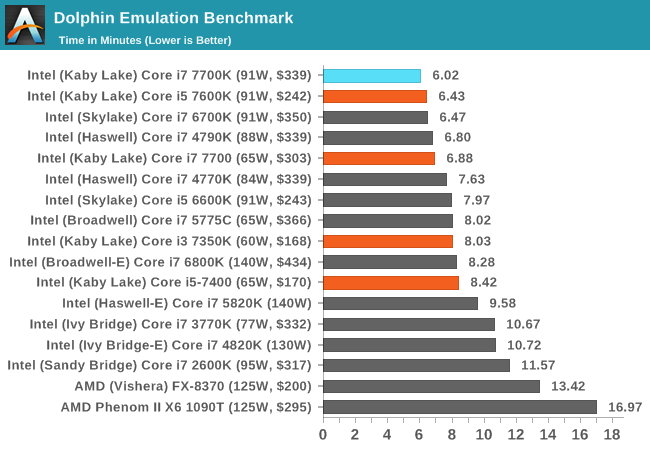
As shown by the data, the i7-7700K takes the top spot. At stock it edges out an overclocked Core i7-4790K at 4.7 GHz, which is no mean feat. Dolphin is all about high frequency and IPC, which the i7-7700K has the best of both.
WinRAR 5.0.1: link
Our WinRAR test from 2013 is updated to the latest version of WinRAR at the start of 2014. We compress a set of 2867 files across 320 folders totaling 1.52 GB in size – 95% of these files are small typical website files, and the rest (90% of the size) are small 30 second 720p videos.
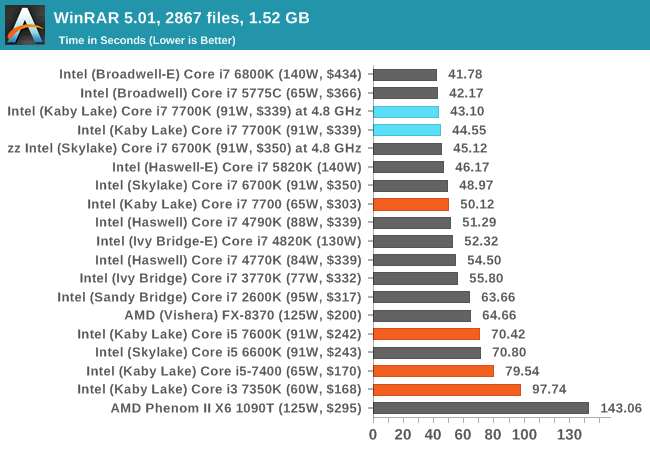
WinRAR is more geared towards a variable threaded environment but also memory speed. While two channels of DDR4-2400 does well for the Core i7-7700K, to the point where it beats the 6-core i7-5930K, anything with eDRAM (i7-5775C) and the higher end quad channel processors with up to 10 cores do win out. But at $1700 for 10-core, the Kaby Lake CPU does well – the only processor that beats it in its price range is that eDRAM-based i7 part.
3D Particle Movement v2
3DPM is a self-penned benchmark, taking basic 3D movement algorithms used in Brownian Motion simulations and testing them for speed. High floating point performance, MHz and IPC wins the day. This is the second variant of this benchmark, fixing for false sharing in the first version, and lending itself to better multithreaded performance.
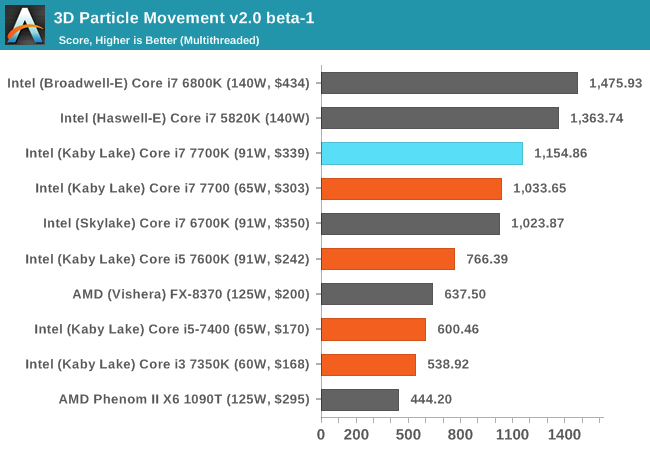
3DPMv2 is still new, so we don’t have too many results for it so far, but it hits the top of the mainstream processor stack as was perhaps to be expected. It scores almost double an FX-8370, showing how far Intel’s mainstream has come from AMD’s old CPUs, but the Core i7-7700K matches up to just over double the Core i3-7350K, as it has double the cores/threads and slightly more frequency.
SYSMark 2014
Engineered by BAPco (to which Intel is a consortium member), this set of tests are designed to be an office/data/media/financial range of tests using common well-known CAD, image editing, web browsing and other tools to put out a score, where a score of 1000 is attributed to an old Core i3 using a mechanical harddrive. Here we report the overall score, however the test breakdowns can be found in Bench.
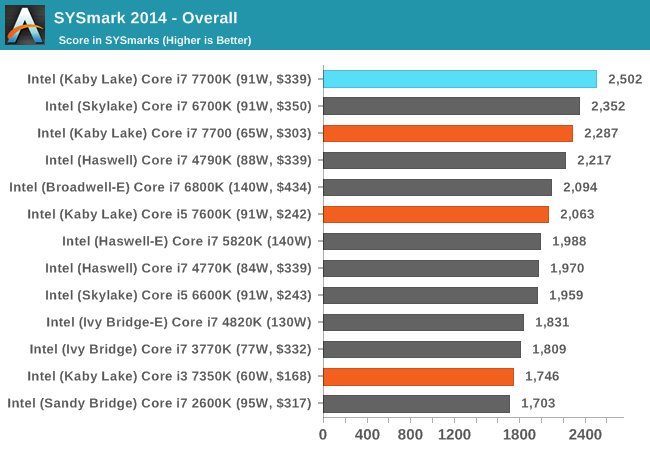
Because SYSMark is a variety of tests that rely on response and throughput, the Core i7-7700K hits the mix just right and scores higher than even a 10-core Core i7 Extreme part launched last year, as well as a highly overclocked Devil’s Canyon. Aside from the Core i5, the 7700K does well in price/performance here.
Web Benchmarks
On the lower end processors, general usability is a big factor of experience, especially as we move into the HTML5 era of web browsing. For our web benchmarks, we take well known tests with Chrome as installed by SYSMark as a consistent browser.
Mozilla Kraken 1.1
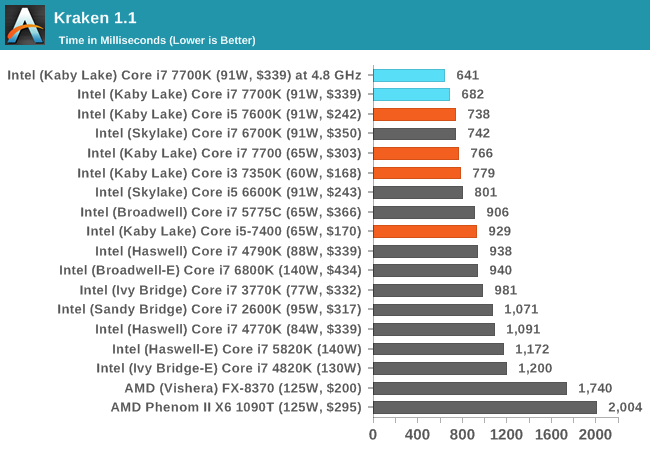
Google Octane v2
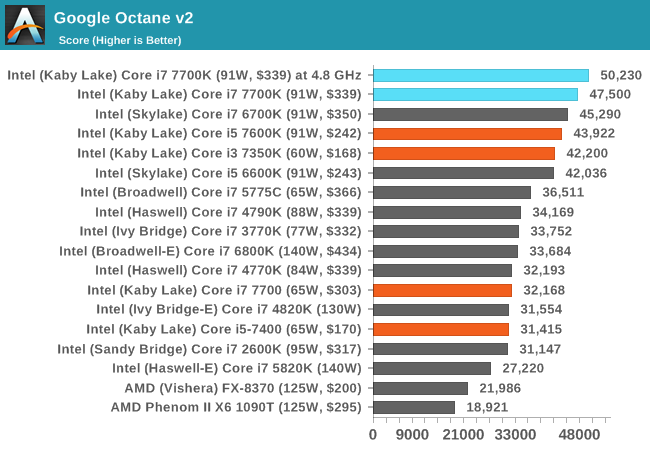










125 Comments
View All Comments
RichUK - Tuesday, January 3, 2017 - link
Very thorough review, thank you!Shame you didn't get a better sample.
Will you look to do a focused review around delidding and the associated overlooking benefits?
RichUK - Tuesday, January 3, 2017 - link
That's should read 'overclocking' - Damn auto correct on my phone!close - Wednesday, January 4, 2017 - link
Yeah... great review that calls a CPU that's basically identical to the previous generation as "The New Out-of-the-box Performance Champion". While mathematically it can be considered true I think such a title is grossly misleading.Intel brought almost 0 improvements over generations but didn't bother dropping the price accordingly. This isn't "the new champion", this is last year's CPU a little overclocked. The fact that it comes "pre-overclocked" doesn't make it a champion nor does it make the title and conclusion of this article any more valuable.
We'll see how Zen does but if it offers similar performance to Intel's offerings for substantially less money a lot of journalists will have to backtrack on their "Intel's having a hard time advancing performance because there's no more headroom and prices can't go down due to research and fabrication costs".
close - Wednesday, January 4, 2017 - link
Also this: http://arstechnica.com/gadgets/2017/01/intel-core-...Arstechnica's conclusions:
"With identical performance to Skylake, Intel brings desktop performance to a standstill."
"the Kaby Lake desktop chips are but a mere clock speed boost disguised under the nomenclature of a new CPU generation. From an IPC standpoint, there's nothing to tell Kaby Lake apart from Skylake"
AnandTech's conclusions:
"The New Champion"
"The Core i7-7700K sits at the top of the stack, and performs like it."
"handily mops the floor with the Devil’s Canyon part [nb, 3 year old part!], resigning it to history."
Intel are selling yesterday's soup, reheated but at the same price and Ian is trying hard to make everyone think that soup is like wine, it gets better with age. The truth is that there's basically no reason whatsoever to upgrade this year since we're still talking about a 6700K with 200MHz. *ANY* user buying a K part should be able to achieve that with last year's CPUs.
close - Wednesday, January 4, 2017 - link
P.S. Devil's Canyon is actually a 4 year old part that was overclocked and relaunched 3 years ago. So it's "refreshing" to see how AnandTech gets excited about a brand new CPU that manages to be ~10% faster than a 4 year old CPU with slightly lower (boost) clocks in office/workstation scenarios and which brings 0 benefits in gaming scenarios. That would be a ~5% average improvement for a user.Wow Ian, it really doesn't take much to get you all hyped up these days, does it?
Lolimaster - Wednesday, January 4, 2017 - link
Anandtech was a shill site for a long time, Kaby Lake was going to prove whose site is that. Doubts answered.pogostick - Wednesday, January 4, 2017 - link
The best line is the first line: "The Intel Core i7-7700K is what happens when a chip company stops trying."slickr - Wednesday, January 4, 2017 - link
Yeah, very suspicious of Ian. Is he getting paid to shill for Intel or is he that BAD at journalism!?fanofanand - Thursday, January 26, 2017 - link
As someone who has read Ian's work for years, he is no shill. I disagree with his politics, but he is a good, honest journalist. Was he overly generous in this piece? No doubt. Calling it a great overclocked then saying it only boosts 300 MHz was a giveaway there. I am quite certain purch wanted this to go out as a softer piece for the $$$$, so Ian disguised his contempt the best he could. Look for the clues, they are there. Only reason to go Kaby is if you really want an optane cache. He kind of made that clear I thought.RichUK - Thursday, January 5, 2017 - link
I skipped to the overclocking section and didn't read the rest. ;) That's all I'm interested in.